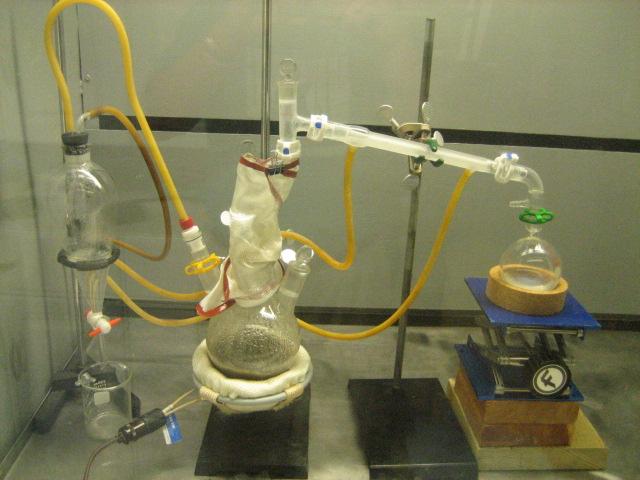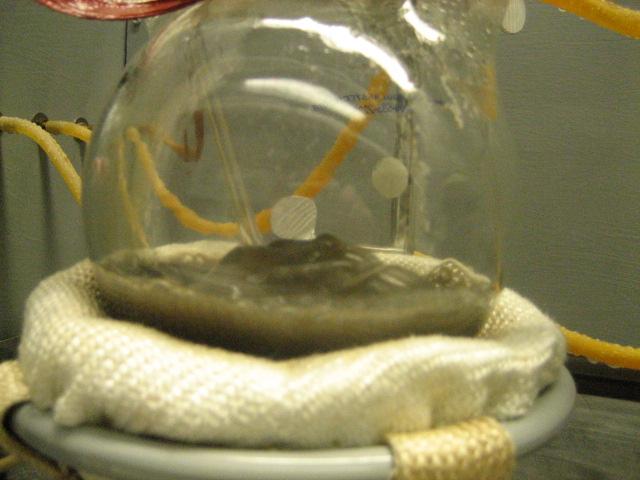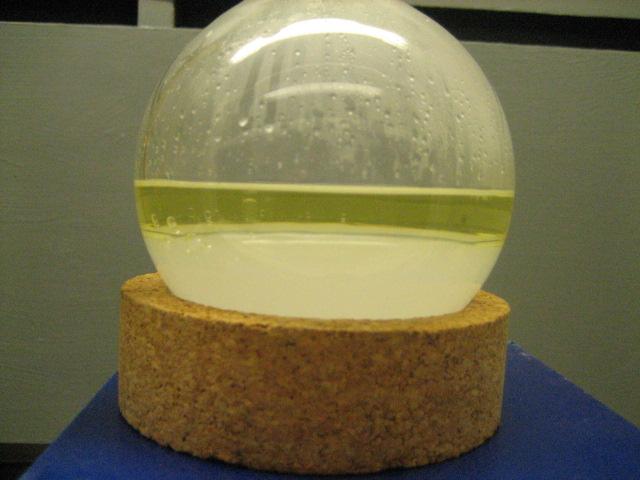| Pages:
1
2 |
not_important
International Hazard
    
Posts: 3873
Registered: 21-7-2006
Member Is Offline
Mood: No Mood
|
|
In many cases the best way for steam generation is to return the condensate to the boiler, any product that remains in the water goes up in the steam.
This is easiest with the single pot (no separate steam feed) method, on a large scale a a return to the separate boiler is worth the work. If the
product has a very low water solubility this isn't a concern.
As already stated, steam distillation is a subset of codistillation. Other liquids have been used, kerosene and mercury amount them; even gases can be
used. In all cases they allow distillation of materials at temperatures well below their boiling points; when one substance has little association
with water while another has a higher degree of association, steam distillation allows separation even if the substances boiling points are close -
see the preparation of o- and p- nitrophenol from nitration of phenol.
Oxidation isn't much of a concern as the vapours quickly drive out air from the system. Overheating is of little concern as well, if you are using a
separate steam feed it is common to heat the pot itself as well but you can either control that temperature or place a little concentrated salt
solution in it to limit the pot temperature - if the aqueous salt phase gets too small lower the pot temperature a bit.
|
|
|
peach
Bon Vivant
    
Posts: 1428
Registered: 14-11-2008
Member Is Offline
Mood: No Mood
|
|
Mercury 'steam distillations'? Excellent! 
I know they do p- o- separation of xylene through zeolite now, or I've seen a patent for it anyway; but that could mean anything.
|
|
|
Magpie
lab constructor
    
Posts: 5939
Registered: 1-11-2003
Location: USA
Member Is Offline
Mood: Chemistry: the subtle science.
|
|
Quote: Originally posted by chemrox  | | Single flask steam distillation is not a very good technique. It's much better to run live steam into the flask with the material in it. This way
the oils co-distill right away rather than sitting in boiling water where they are more labile to oxidation. I have a pressure cooker converted to
release a continuous course of steam and a water collector in line to capture any condensate. Lab instructors often oversimplify in favor of
completing the task in the allocated time. |
Some lab procedures call for the single flask distillation, eg, that for making malachite green in Brewster et al, and that for recovering clove oil
in Pavia et al. I'm still wondering if there aren't reasons for selecting this method over live steam injection other than simplicity and saving
time.
The single most important condition for a successful synthesis is good mixing - Nicodem
|
|
|
Magpie
lab constructor
    
Posts: 5939
Registered: 1-11-2003
Location: USA
Member Is Offline
Mood: Chemistry: the subtle science.
|
|
Today I had need to use steam distillation in a workup for N,N-dimethylaniline. I used a combination of live steam and direct heat. Now that I
recall this is what I usually do, especially when the pot is relatively large as in this case, a 1000mL RBF. This supplies enough heat to keep the
distillation rate up to the maximum capacity of the condenser, which is ice water cooled. The live steam injector does a great job of keeping
everything well agitated, which maximizes heat transfer and liquid surface area.
  
The single most important condition for a successful synthesis is good mixing - Nicodem
|
|
|
Ephesian
Hazard to Self
 
Posts: 97
Registered: 14-8-2012
Member Is Offline
Mood: No Mood
|
|
Magpie I'm trying to decipher your set up... From what I see you're passing steam through your sep funnel which leads back into your reaction vessel.
Is the purpose of this to minimize excess water in the reaction vessel that is not contributing to driving your product over to the collection flask?
|
|
|
Magpie
lab constructor
    
Posts: 5939
Registered: 1-11-2003
Location: USA
Member Is Offline
Mood: Chemistry: the subtle science.
|
|
Quote: Originally posted by Ephesian  | | Magpie I'm trying to decipher your set up... From what I see you're passing steam through your sep funnel which leads back into your reaction vessel.
Is the purpose of this to minimize excess water in the reaction vessel that is not contributing to driving your product over to the collection flask?
|
Yes.
The 500mL separatory funnel is just a drop-out pot for condensate that forms in the steam line. A smaller funnel could be used - you would just have
to drain it more often.
The single most important condition for a successful synthesis is good mixing - Nicodem
|
|
|
| Pages:
1
2 |